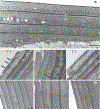Trichothiodystrophy hair shafts display distinct ultrastructural features
- PMID: 35615778
- PMCID: PMC10575343
- DOI: 10.1111/exd.14614
Trichothiodystrophy hair shafts display distinct ultrastructural features
Abstract
Hair shafts from three trichothiodystrophy (TTD) patients with mutations in the ERCC2 (XPD) gene were examined by transmission electron microscopy. TTD is a rare, recessive disorder with mutations in several genes in the DNA repair/transcription pathway, including ERCC2. Unlike previous studies, the hair shafts were examined after relaxation of their structure by partial disulphide bond reduction in the presence of sodium dodecyl sulphate, permitting improved visualization. Compared with hair shafts of normal phenotype, TTD cuticle cells displayed aberrant marginal bands and exocuticle layers. Clusters of cells stained differently (light versus dark) in the cortex of aberrant shafts, and the keratin macrofibrils appeared much shorter in the cytoplasm. Considerable heterogeneity in these properties was evident among samples and even along the length of single hair shafts. The results are consistent with not only a paucity of high sulphur components, such as keratin-associated proteins, but also a profound imbalance in protein content and organization.
Keywords: DNA repair/transcription disease; hair cortex; hair exocuticle; keratin macrofibrils; marginal band; neuroectodermal genodermatosis; transmission electron microscopy.
© 2022 John Wiley & Sons Ltd. This article has been contributed to by U.S. Government employees and their work is in the public domain in the USA.
Conflict of interest statement
CONFLICT OF INTEREST
The authors state that they have no conflict of interest.
Figures



References
Publication types
MeSH terms
Substances
Grants and funding
LinkOut - more resources
Full Text Sources
Medical
Research Materials

